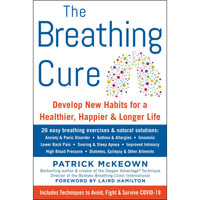
Ventilator Management Strategies for Critical Care
By: Nicholas Hill (Editor), Mitchell M. Levy (Editor)
Hardcover | 15 June 2001 | Edition Number 1
At a Glance
832 Pages
23.5 x 15.88 x 4.45
Hardcover
RRP $420.00
$297.25
29%OFF
or 4 interest-free payments of $74.31 with
orAvailable for Backorder. We will order this from our supplier however there isn't a current ETA.
This state-of-the-art reference provides current and effective disease-specific strategies for the management of patients receiving mechanical ventilation-emphasizing weaning processes, monitored sedation, minimization of complications and infection, and new modes of treatment for patients in critical care.
Exploring ancillary approaches, noninvasive positive pressure ventilation, oxygenation, and bronchodilator therapy as options to optimize cost and reduce injury, Ventilator Management Strategies for Critical Care discusses
With contributions by over 40 seasoned experts in the field, Ventilator Management Strategies for Critical Care is a valuable resource for intensive or critical care and pulmonary or critical care specialists, surgical critical care specialists, anesthesiologists, physiologists, physiatrists and rehabilitation physicians, respiratory therapists, and medical school and graduate students in these disciplines.
Industry Reviews
| Series Introduction | p. iii |
| Preface | p. v |
| Contributors | p. ix |
| Demographics And Epidemiology | |
| Epidemiology of Acute Respiratory Failure | p. 1 |
| Introduction | p. 1 |
| What Is Acute Respiratory Failure? | p. 2 |
| Type 1 Acute Respiratory Failure | p. 3 |
| Type 2 Acute Respiratory Failure | p. 4 |
| Indications for Intubation with or Without Assisted Ventilation | p. 6 |
| Etiology of Acute Respiratory Failure | p. 7 |
| Acute Respiratory Distress Syndrome | p. 14 |
| Chronic Obstructive Pulmonary Disease | p. 21 |
| Summary | p. 28 |
| References | p. 28 |
| Evolution of the Modern Mechanical Ventilator | p. 37 |
| Evolution of the Concepts Underlying Mechanical Ventilation | p. 37 |
| Devices Used for Resuscitation | p. 38 |
| Devices Used for Ventilatory Support of Healthy Lungs | p. 40 |
| Devices Designed for Respiratory Support of Diseased Lungs--The Modern Era | p. 41 |
| Mechanical Ventilation--Current Status | p. 46 |
| Mechanical Ventilation--Challenges for the Future | p. 47 |
| Conclusion | p. 48 |
| References | p. 49 |
| Utilization of Mechanical Ventilation for Critical Care: An International Perspective | p. 53 |
| Introduction | p. 53 |
| The Use of Mechanical Ventilation | p. 54 |
| Duration of Mechanical Ventilation: Effect on Morbidity and Mortality | p. 56 |
| Demographic Characteristics of Patients Who Undergo Mechanical Ventilation | p. 62 |
| Airway Management | p. 67 |
| Ventilator Modes and Settings | p. 68 |
| Weaning Techniques | p. 71 |
| The Economic Impact of Mechanical Ventilation | p. 72 |
| Conclusion | p. 73 |
| References | p. 74 |
| Costs Associated with Mechanical Ventilation | p. 79 |
| Introduction | p. 79 |
| Economic Terminology | p. 81 |
| Cost of Mechanical Ventilation in Critical Care | p. 85 |
| Effects of Specific Diagnoses on Costs and Outcomes of Mechanical Ventilation | p. 89 |
| Economics and Outcomes of Patients Transferred Out of the ICU to Less Acute Settings | p. 91 |
| Outcome Prediction and the Decision to Use Mechanical Ventilation | p. 95 |
| Noninvasive Positive Pressure Ventilation as a Cost-Saving Technique | p. 95 |
| Ancillary Approaches to Decrease Cost for Mechanical Ventilation of ICU Patients | p. 98 |
| Organizational Issues and Optimal Management of Mechanical Ventilation | p. 101 |
| Conclusion | p. 105 |
| References | p. 106 |
| Strategies for Optimal Utilization of Mechanical Ventilation in Critical Care | |
| Mechanical Ventilation: Protocol-Driven Strategies | p. 111 |
| Introduction | p. 111 |
| Why Use Protocols and Guidelines? | p. 112 |
| How Do Protocols and Guidelines Work? | p. 114 |
| How Do You Successfully Develop and Implement a Protocol or Guideline? | p. 116 |
| Using Formal Multidisciplinary Teams for the Management of Mechanical Ventilation | p. 119 |
| Protocol-Guided Management of Mechanical Ventilation | p. 121 |
| Protocol Management of Innovative Mechanical Ventilation Strategies | p. 126 |
| Summary | p. 128 |
| References | p. 129 |
| Noninvasive Ventilation: A Strategy to Improve Outcomes and Resource Utilization in Critical Care | p. 137 |
| Introduction | p. 137 |
| Rationale | p. 138 |
| General Considerations for Patient Selection in the Acute Setting | p. 138 |
| Appropriate Recipients of NPPV | p. 140 |
| Practical Application of NPPV in the Critical Care Setting | p. 144 |
| Effects of NPPV on Patient Outcomes | p. 156 |
| Summary and Conclusions | p. 165 |
| References | p. 166 |
| New Modes of Ventilation | p. 171 |
| Introduction | p. 171 |
| The Ventilator Trigger | p. 172 |
| Pressure Ventilation | p. 181 |
| Dual Control Modes | p. 199 |
| AutoMode | p. 208 |
| Mandatory Minute Ventilation | p. 208 |
| Adaptive Support Ventilation | p. 209 |
| Conclusions | p. 211 |
| References | p. 211 |
| Closed Loop Mechanical Ventilation | p. 223 |
| Introduction | p. 223 |
| What Is Closed Loop Ventilation? | p. 224 |
| Computer Decision Support Systems Versus True Closed Loops | p. 224 |
| How Does Closed Loop Ventilation Work? | p. 225 |
| Inputs | p. 225 |
| Gas Exchange | p. 225 |
| Mechanics | p. 226 |
| Patient Respiratory Drive (P[subscript 0.1]) | p. 233 |
| Inputs Summary | p. 234 |
| Outputs | p. 234 |
| Respiratory Rate and Tidal Volume | p. 234 |
| I:E Ratio | p. 237 |
| Weaning | p. 237 |
| Future Directions | p. 238 |
| References | p. 239 |
| Treatment of Agitation and Its Comorbidities in the Intensive Care Unit | p. 243 |
| Agitation in the ICU | p. 243 |
| Delirium in the ICU | p. 245 |
| Brain Failure and Delirium | p. 246 |
| Clinical Presentations of Brain Failure | p. 247 |
| Comorbidities of Brain Failure and Delirium | p. 248 |
| Rational Treatment of Agitation and Its Comorbidities | p. 252 |
| Treatment of Anxiety and Discomfort | p. 260 |
| Selecting the Most Efficacious Drug Therapy | p. 263 |
| Continuous Infusions in the ICU: Current Experience | p. 264 |
| Analgesia and Sedation Combinations: Role of Fentanyl | p. 268 |
| Management of Agitation in Organ System Failure | p. 270 |
| Clearance of Commonly Used ICU Sedatives and Analgesics | p. 272 |
| Role of Sedative-Reversal Agents in the ICU | p. 273 |
| Life-Threatening Agitation in the ICU | p. 274 |
| Anxiolysis During Withdrawal of Life Support | p. 275 |
| Palliating the Dying Process During Respiratory Failure | p. 276 |
| References | p. 277 |
| Optimal Airway Management in Ventilated Patients | p. 285 |
| Introduction | p. 285 |
| Artificial Airway Placement | p. 286 |
| Artificial Airway Maintenance | p. 301 |
| Artificial Airway Discontinuation | p. 313 |
| Overall Summary | p. 315 |
| References | p. 317 |
| Ventilatory Strategies for Specific Causes of Respiratory Failure | |
| Ventilator Management Strategies for Acute Asthma | p. 327 |
| Introduction | p. 327 |
| Pathophysiology | p. 328 |
| Preventing Intubation | p. 330 |
| Intubation | p. 332 |
| Postintubation Hypotension | p. 334 |
| Initial Ventilator Settings | p. 334 |
| Assessing Dynamic Hyperinflation | p. 338 |
| Ventilator Adjustments | p. 341 |
| Sedation and Paralysis | p. 342 |
| Bronchodilator Delivery During Mechanical Ventilation | p. 344 |
| Adjunctive Therapies During Mechanical Ventilation | p. 345 |
| Summary and Conclusion | p. 346 |
| References | p. 346 |
| Ventilator Management Strategies for COPD Patients | p. 353 |
| Introduction | p. 353 |
| Pathophysiology of Ventilatory Impairment in COPD | p. 354 |
| Noninvasive Ventilation for Exacerbations of COPD | p. 363 |
| Invasive Mechanical Ventilation for Acute Respiratory Failure in COPD | p. 374 |
| Summary and Conclusions | p. 384 |
| References | p. 385 |
| Strategies of Mechanical Ventilation in Patients with Acute Respiratory Distress Syndrome | p. 393 |
| Introduction | p. 393 |
| Background | p. 394 |
| Ventilator-Induced Lung Injury | p. 394 |
| Alveolar Recruitment | p. 398 |
| Modes of Mechanical Ventilation in ARDS | p. 405 |
| Ventilation Strategies in ARDS | p. 408 |
| Alternative Modes of Mechanical Ventilation in ARDS | p. 416 |
| Adjuvants to Mechanical Ventilation in ARDS | p. 429 |
| Summary and Conclusions | p. 432 |
| References | p. 433 |
| Noninvasive Positive-Pressure Ventilation in Acute Respiratory Failure Not Related to Chronic Obstructive Pulmonary Disease | p. 451 |
| Introduction | p. 451 |
| Hypercapnic Respiratory Failure | p. 453 |
| Hypoxemic Respiratory Failure | p. 462 |
| Patients with Advanced Disease | p. 480 |
| Postextubation Respiratory Failure and Difficult Weaning | p. 481 |
| Conclusions | p. 483 |
| References | p. 483 |
| Strategies to Facilitate the Weaning Process | |
| Strategies for Predicting Successful Weaning from Mechanical Ventilation | p. 499 |
| Introduction | p. 499 |
| Why Obtain Weaning Predictors? | p. 500 |
| Pathophysiology of Weaning Failure | p. 501 |
| Reintubation | p. 504 |
| General Principles in the Evaluation of Weaning Predictors | p. 506 |
| Specific Weaning Predictors | p. 509 |
| Summary | p. 521 |
| References | p. 522 |
| Optimizing the Efficiency of Weaning from Mechanical Ventilation | p. 531 |
| Introduction | p. 531 |
| Prospective Randomized Controlled Trials--What Have We Learned? | p. 532 |
| Daily Screening Techniques | p. 536 |
| Spontaneous Breathing Trials | p. 538 |
| Prediction Models | p. 541 |
| Large-Scale Implementation of a Protocol | p. 544 |
| Outcomes of Mechanically Ventilated Patients | p. 547 |
| Further Discussion of Implementation of Therapist-Driven Protocol | p. 548 |
| Compliance with the Protocol | p. 549 |
| Other Barriers to Protocol Compliance | p. 551 |
| Additional Caveats | p. 552 |
| Patient Subgroups | p. 553 |
| Reintubations: Distinguishing Causes | p. 563 |
| Conclusions | p. 566 |
| References | p. 570 |
| Noninvasive Ventilation to Facilitate Weaning from Mechanical Ventilation | p. 579 |
| A Word Lesson | p. 579 |
| Weaning Failure and Prolonged Ventilation | p. 580 |
| Avoiding Intubation | p. 583 |
| Reducing the Duration of Mechanical Ventilation | p. 585 |
| Weaning Through Noninvasive Ventilation | p. 586 |
| Future Applications | p. 597 |
| Conclusions | p. 600 |
| References | p. 601 |
| Strategies to Minimize Complications of Mechanical Ventilation | |
| Strategies to Avoid Ventilator-Induced Lung Injury | p. 611 |
| Introduction | p. 611 |
| Evidence for VILI | p. 611 |
| Strategies to Prevent VILI | p. 619 |
| Clinical Studies | p. 625 |
| Conclusion | p. 628 |
| References | p. 629 |
| Strategies for Diagnosing, Managing, and Avoiding Ventilator-Associated Pneumonia | p. 635 |
| Introduction | p. 635 |
| Epidemiology | p. 636 |
| Pathogenesis | p. 637 |
| Diagnosis | p. 638 |
| Treatment | p. 641 |
| Risk Factors and Prevention | p. 642 |
| Summary | p. 646 |
| References | p. 646 |
| Effects of Mechanical Ventilation on Heart-Lung Interactions | p. 655 |
| Introduction | p. 655 |
| Spontaneous Ventilation Is Exercise | p. 656 |
| Inspiration Increases Lung Volume | p. 657 |
| Relationship Between Airway Pressure, Intrathoracic Pressure, and Lung Volume | p. 663 |
| Hemodynamic Effects of Changes in Intrathoracic Pressure | p. 668 |
| Patient-Specific Heart--Lung Interactions | p. 678 |
| Summary and Conclusions | p. 681 |
| References | p. 682 |
| Outcomes of Mechanical Ventilation | |
| Extubation Failure: Predictions and Consequences | p. 693 |
| Introduction | p. 693 |
| Prevalence of Extubation Failure | p. 694 |
| Pathophysiology of Extubation Failure | p. 702 |
| Extubation Outcome | p. 708 |
| Prediction of Extubation Outcome | p. 714 |
| Treatment and Prevention of Extubation Failure | p. 727 |
| Unplanned Extubation Failure | p. 729 |
| Summary | p. 731 |
| References | p. 732 |
| "Pulling the Plug": Ethical Considerations in the Withholding and Withdrawal of Mechanical Ventilation | p. 743 |
| Introduction | p. 743 |
| Case Law | p. 744 |
| Limiting Agreement | p. 746 |
| Terminal Weaning | p. 748 |
| Pain Control | p. 749 |
| Summary and Conclusions | p. 752 |
| References | p. 752 |
| Author Index | p. 755 |
| Subject Index | p. 813 |
| Table of Contents provided by Syndetics. All Rights Reserved. |
ISBN: 9780824705220
ISBN-10: 082470522X
Series: Lung Biology in Health and Disease
Published: 15th June 2001
Format: Hardcover
Language: English
Number of Pages: 832
Audience: Professional and Scholarly
Publisher: INFORMA MEDICAL
Country of Publication: US
Edition Number: 1
Dimensions (cm): 23.5 x 15.88 x 4.45
Weight (kg): 1.34
Shipping
| Standard Shipping | Express Shipping | |
|---|---|---|
| Metro postcodes: | $9.99 | $14.95 |
| Regional postcodes: | $9.99 | $14.95 |
| Rural postcodes: | $9.99 | $14.95 |
How to return your order
At Booktopia, we offer hassle-free returns in accordance with our returns policy. If you wish to return an item, please get in touch with Booktopia Customer Care.
Additional postage charges may be applicable.
Defective items
If there is a problem with any of the items received for your order then the Booktopia Customer Care team is ready to assist you.
For more info please visit our Help Centre.
You Can Find This Book In
This product is categorised by
- Non-FictionMedicineOther Branches of MedicineTherapy & Therapeutics
- Non-FictionMedicineOther Branches of MedicineAccident & Emergency MedicineIntensive Care Medicine
- Non-FictionMedicineClinical & Internal MedicineRespiratory Medicine
- Non-FictionMedicineMedicine in GeneralMedical Equipment & Techniques
- Non-FictionMedicineSurgeryCritical Care Surgery























